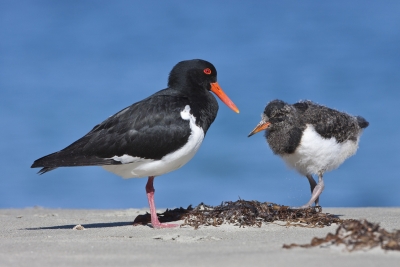On this page
Shorebirds
Migrating shorebirds fly up to 12,000 kilometres from Arctic breeding areas to Western Port.

Quick facts
- The Bar-tailed Godwit uses its long beak to find enough fuel for the longest non-stop flight of any bird, over 11,000 kilometres to Alaska
- The Pied Oystercatcher (pictured above) is a black and white bird, common on the shores of Western Port
- The migratory Red-necked Stint refuels at Western Port for its annual flight to Siberia
- The Eastern Curlew feeds on the mudflats with its long probing beak, eating crabs, molluscs and worms
Help protect them
- Do not approach shorebirds or waders onshore and minimise boating activity near birds
- Obey regulations for shore access
- Keep dogs on a leash and cats inside at night
Download the shorebirds factsheet for more information.
Underwater creatures
The rocky reefs, sandy plains and sponge gardens are home to many species of underwater animals.

Quick facts
- Abalone, crayfish and crabs live with weedy seadragons, seahorses and nudibranchs
- Seagrass meadows are a 'fish nursery' for juvenile fish
- Western Port is home to 3 national marine parks
Help protect them
- Obey all rules and regulations when in the Marine National Parks
- When boating, dispose of rubbish onshore and avoid discharging waste and ballast
- Explore the underwater treasures by diving and snorkelling
Download the underwater treasures factsheet for more information.
